Xian Tours
Beijing Tours
China Tour Packages
About
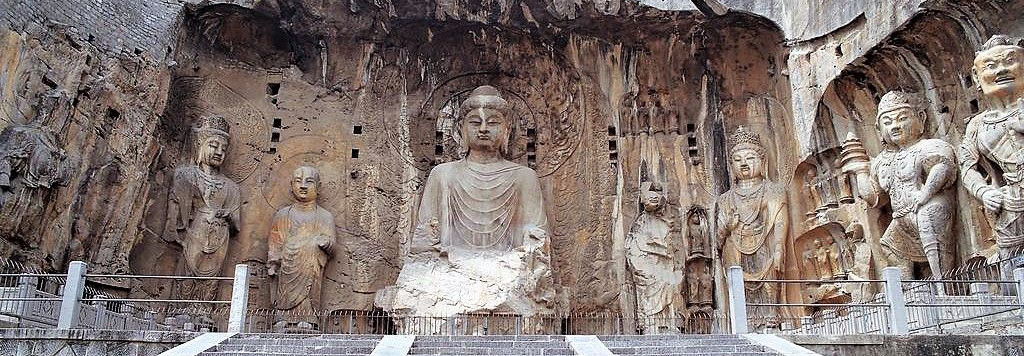
Set on the banks of the Yi River, 12km south of the current Luoyang City, the Longmen Grottoes are ranked first of the Four Great Grottoes in China, together with Mogao Grottoes in Dunhuang, Yungang Grottoes in Datong and Mount Maiji Grottoes in Tianshui. They were also listed in the World Cultural Heritages and Relics by UNESCO in 2000 for their extensive collection and profound cultural influence on the world. 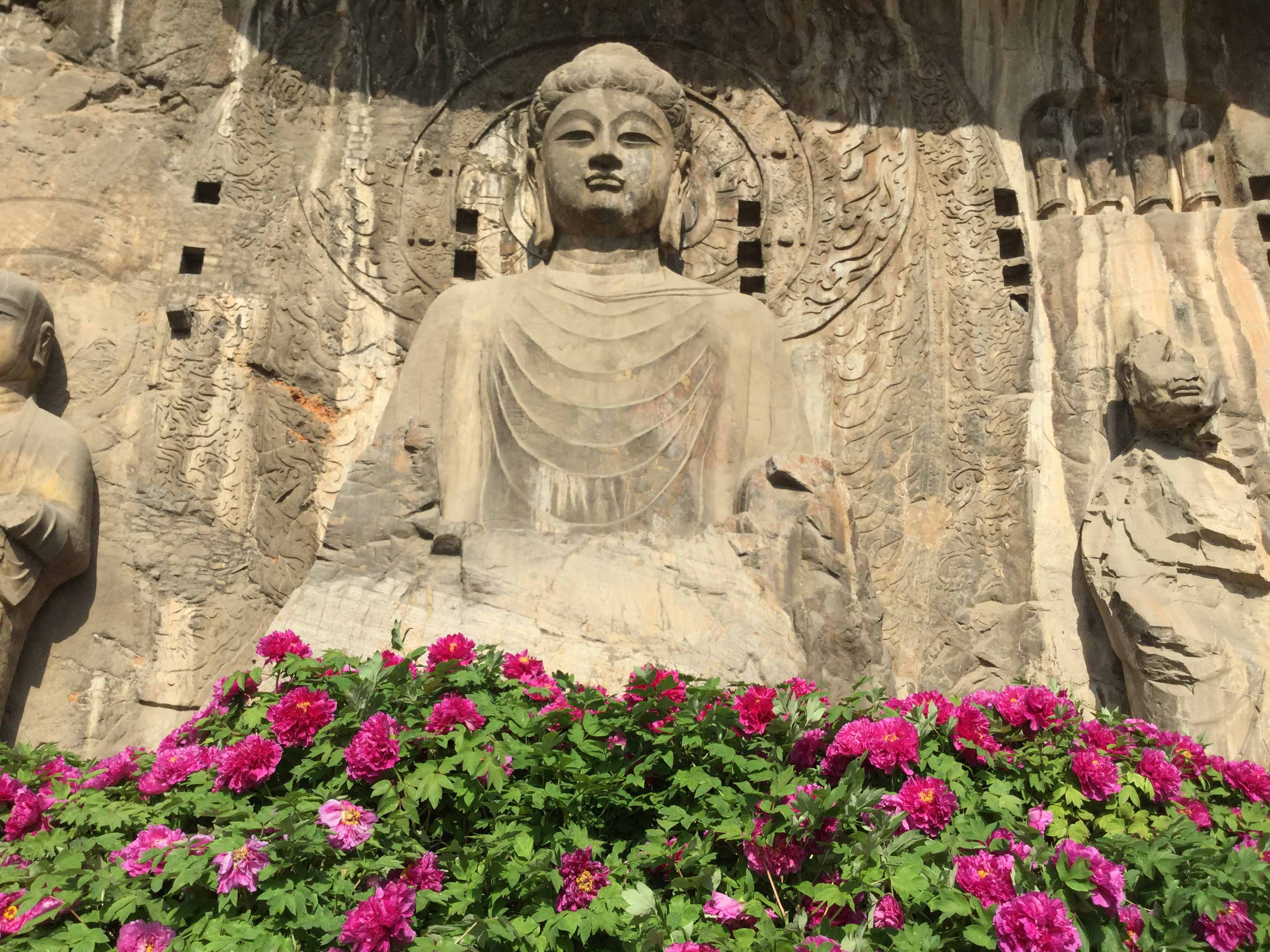 Nestled between the Xiangshan Mountain and the Longmen Mountain, with the Yi River flowing below, the Longmen Grottoes are harmonious with mountains, forests and rivers displaying a serene and peaceful atmosphere.
Nestled between the Xiangshan Mountain and the Longmen Mountain, with the Yi River flowing below, the Longmen Grottoes are harmonious with mountains, forests and rivers displaying a serene and peaceful atmosphere.
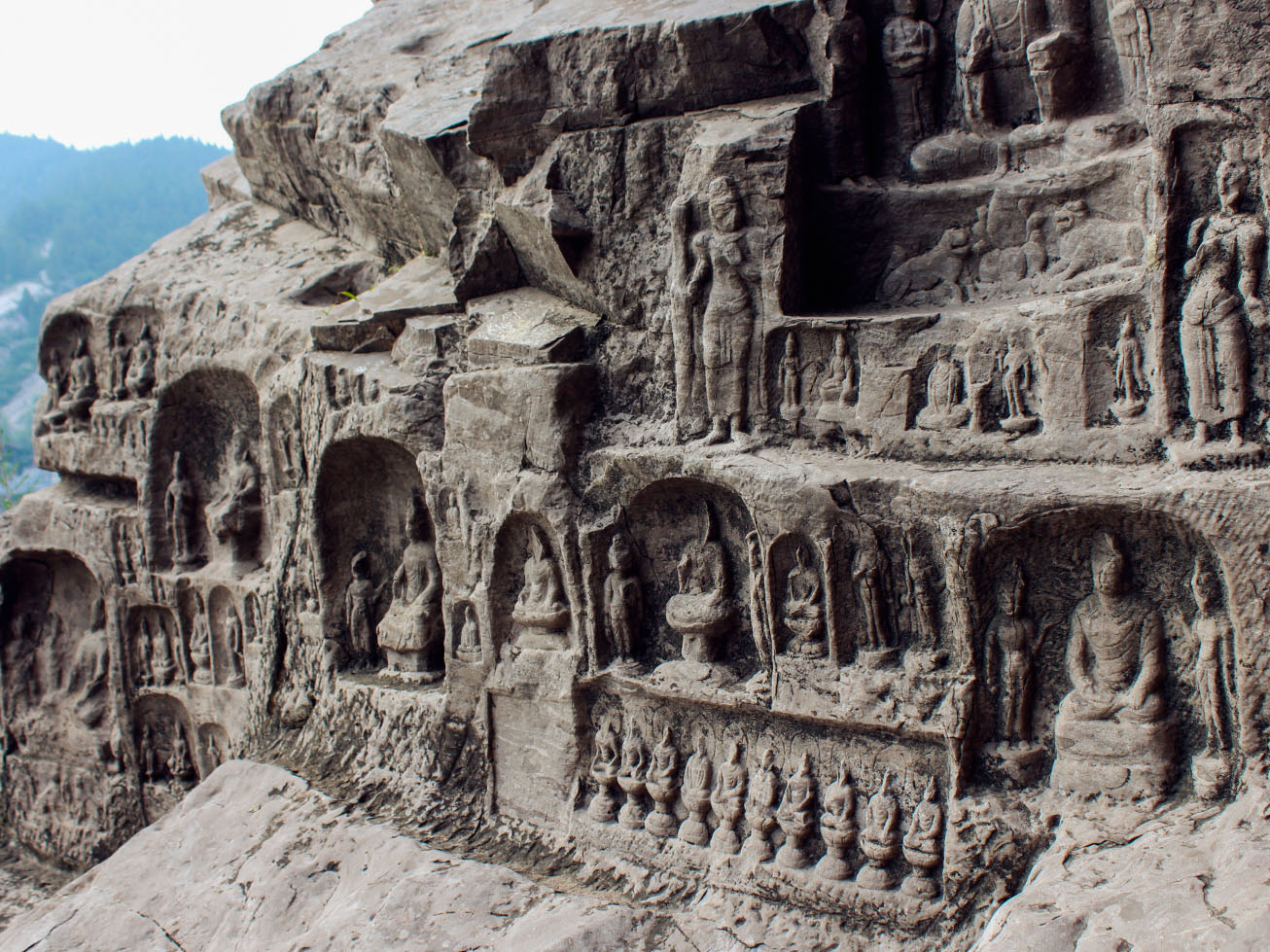 the Yi River with Mount Xiang and Mount Longmen standing on either side. Viewing it at a distance, it looks like a natural gate, which gave it the name “Yi Que (the gate of the Yi River)”. Once when Emperor Yang of the Sui Dynasty climbed on Mount Mang north of Luoyang, he posed the rhetorical question to his subordinates: ‘Isn’t it the gate for a true Emperor? Why didn’t our ancestors establish their capitals here?’ To please the Emperor, one minister replied that it was not that the ancient people didn’t find this place, they were just waiting for the Emperor himself to complete this grand work. The Emperor was very pleased and ordered the eastern capital to be built here with its palace gate opposite the Yique. Thus, it came to be named, Longmen Gate (Dragon Gate: the dragon served as an emblem of Imperial power).
the Yi River with Mount Xiang and Mount Longmen standing on either side. Viewing it at a distance, it looks like a natural gate, which gave it the name “Yi Que (the gate of the Yi River)”. Once when Emperor Yang of the Sui Dynasty climbed on Mount Mang north of Luoyang, he posed the rhetorical question to his subordinates: ‘Isn’t it the gate for a true Emperor? Why didn’t our ancestors establish their capitals here?’ To please the Emperor, one minister replied that it was not that the ancient people didn’t find this place, they were just waiting for the Emperor himself to complete this grand work. The Emperor was very pleased and ordered the eastern capital to be built here with its palace gate opposite the Yique. Thus, it came to be named, Longmen Gate (Dragon Gate: the dragon served as an emblem of Imperial power).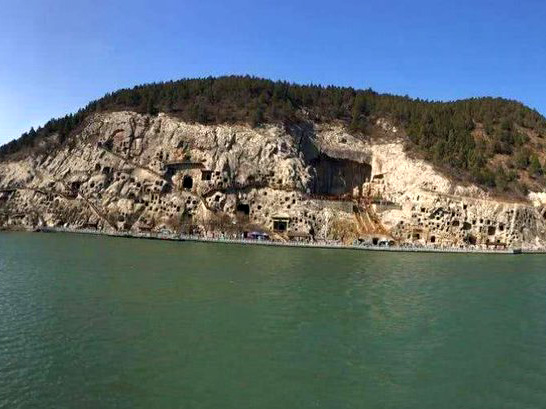 Meanwhile, Luoyang possessed great advantages in location and resources. In 493, the capital relocating process commenced, so did the building of the Longmen Grottoes. This project continued intermittently for 400 years through the Eastern Wei, Western Wei, Northern Qi, Northern Zhou, Sui, Tang and Northern Song Dynasties. Of all the carvings, 30% were from the Northern Wei era, 60% from the Tang period whilst only 10% were made in other times. According to available records, there are presently 2345 statues and niches in the east mountain and and 70 Buddha Pagodas in west one. The Grottoes also house about 2860 stele inscriptions, making it a treasure vault for ancient calligraphy study. In total, more than 100,000 Buddhist statues and niches were carved into the cliffs ranging from the largest one, the Vairocana Buddha with a height of 17.14 meters, to the smallest one of 2 centimeters.
Meanwhile, Luoyang possessed great advantages in location and resources. In 493, the capital relocating process commenced, so did the building of the Longmen Grottoes. This project continued intermittently for 400 years through the Eastern Wei, Western Wei, Northern Qi, Northern Zhou, Sui, Tang and Northern Song Dynasties. Of all the carvings, 30% were from the Northern Wei era, 60% from the Tang period whilst only 10% were made in other times. According to available records, there are presently 2345 statues and niches in the east mountain and and 70 Buddha Pagodas in west one. The Grottoes also house about 2860 stele inscriptions, making it a treasure vault for ancient calligraphy study. In total, more than 100,000 Buddhist statues and niches were carved into the cliffs ranging from the largest one, the Vairocana Buddha with a height of 17.14 meters, to the smallest one of 2 centimeters. While the Tang Dynasty people preferred plumpness, which manifested in effigies with plump faces, broad shoulders and developed chests. It’s precisely such an integration and fusion that make the Longmen Grottoes a grand masterpiece representing the pinnacle of ancient Buddha Effigy art.
While the Tang Dynasty people preferred plumpness, which manifested in effigies with plump faces, broad shoulders and developed chests. It’s precisely such an integration and fusion that make the Longmen Grottoes a grand masterpiece representing the pinnacle of ancient Buddha Effigy art.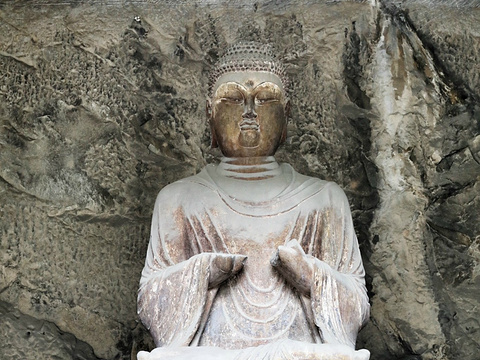 Tang-era caves extending over 30 meters. According to the epigraph, this cave was chiselled during the joint rule of Emperor Gaozong and Wu Zetian, and completed in 675. The Buddha effigy inside the cave displays the distinctive features of Tang Dynasty Buddha art, with a plump face, drooping ears, and chubby body giving an air of peacefulness, compassion and attentiveness. The center Losana Buddha is the largest one in the whole site with a height of 17.14 meters, including 4-meter-high head and 1.9-meter-long ears. It’s allegedly based on its patron Empress Wu Zetian. From a distance, there is a certain resemblance between the Buddha and Empress, at least comparing pictures from the history books or paintings. According to Buddhist sutras, Losana means light shining over the whole world. This effigy looks like a nice, wise middle-aged woman, with her two Bodhisattva disciples, two masculine heavenly kings and two pious guardians standing beside.
Tang-era caves extending over 30 meters. According to the epigraph, this cave was chiselled during the joint rule of Emperor Gaozong and Wu Zetian, and completed in 675. The Buddha effigy inside the cave displays the distinctive features of Tang Dynasty Buddha art, with a plump face, drooping ears, and chubby body giving an air of peacefulness, compassion and attentiveness. The center Losana Buddha is the largest one in the whole site with a height of 17.14 meters, including 4-meter-high head and 1.9-meter-long ears. It’s allegedly based on its patron Empress Wu Zetian. From a distance, there is a certain resemblance between the Buddha and Empress, at least comparing pictures from the history books or paintings. According to Buddhist sutras, Losana means light shining over the whole world. This effigy looks like a nice, wise middle-aged woman, with her two Bodhisattva disciples, two masculine heavenly kings and two pious guardians standing beside.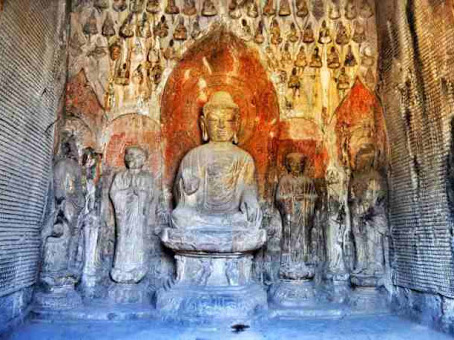 Qianxisi Cave is about 9 meters in height and width, built in the early Tang Dynasty. A splendid bas-relief lotus is carved on the ceiling. The major Buddha Amitabha sits in the center, with a peaceful expression, and fairly-made body. Beside him stand his two disciples. Beside the disciples are Avalokiteshvara and Vajrapani, who with Amitabha are honored to be the three saints of the western happy land.
Qianxisi Cave is about 9 meters in height and width, built in the early Tang Dynasty. A splendid bas-relief lotus is carved on the ceiling. The major Buddha Amitabha sits in the center, with a peaceful expression, and fairly-made body. Beside him stand his two disciples. Beside the disciples are Avalokiteshvara and Vajrapani, who with Amitabha are honored to be the three saints of the western happy land. 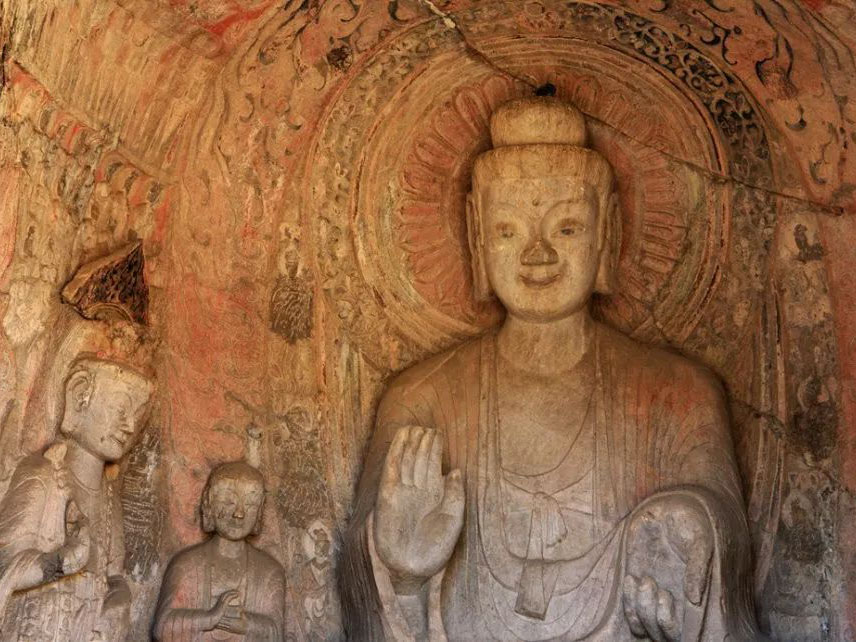 When he was 29 years old, he decided to practice austerity. After 6 years, he succeeded and founded Buddhism. The Sayamuni Buddha is made to be thin in appearance with a slender neck and long body because that was the aesthetic standard back then.
When he was 29 years old, he decided to practice austerity. After 6 years, he succeeded and founded Buddhism. The Sayamuni Buddha is made to be thin in appearance with a slender neck and long body because that was the aesthetic standard back then. 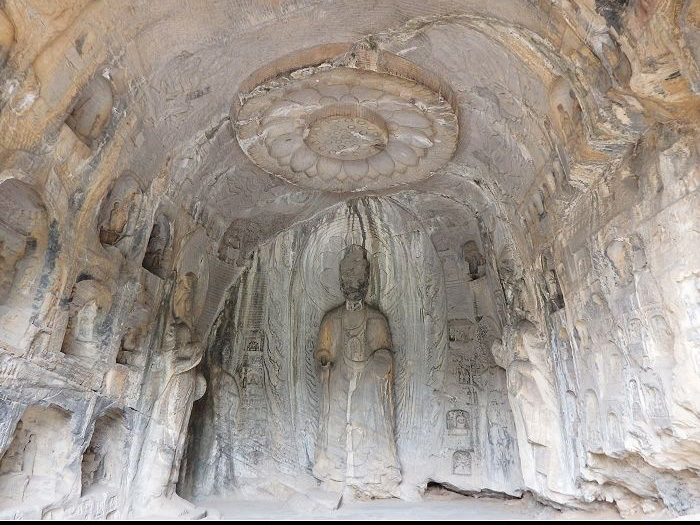 It’s the most complete cave that houses joint-Buddha effigies. Inside the cave, you will see the main Buddha Amitabha and many other figures, all displaying the Tang Dynasty aesthetics.
It’s the most complete cave that houses joint-Buddha effigies. Inside the cave, you will see the main Buddha Amitabha and many other figures, all displaying the Tang Dynasty aesthetics.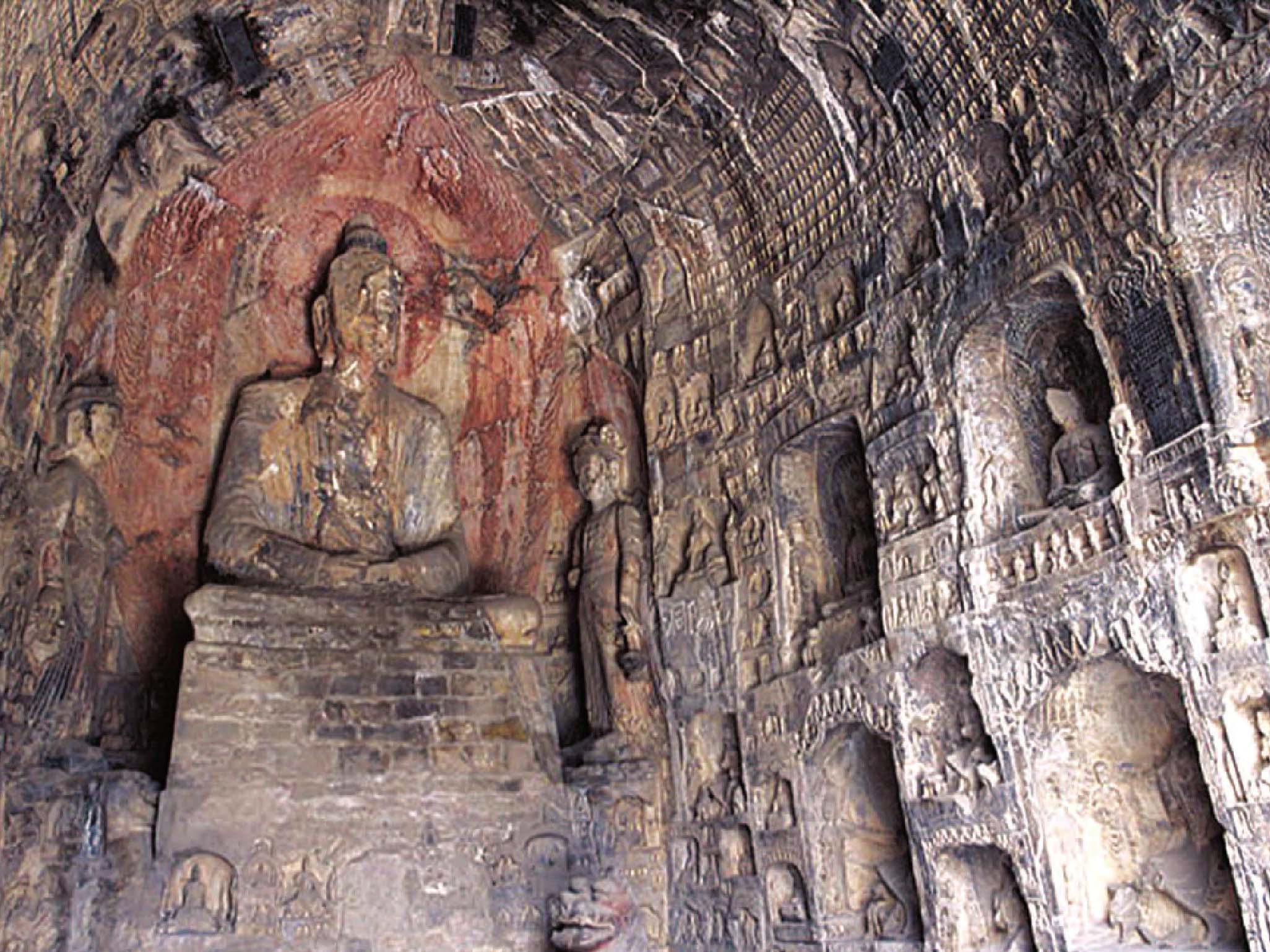 Carving began in 493, which makes it the oldest cave and most abundant with rich calligraphy works. You will find three characters ”古阳洞” on the north wall. In the late Qing Dynasty, Taoist believers refurbished the Sakyamuni effigy into Lord Lao Zi of the Great Monad and spread the rumor that Lao Zi used to practice alchemy there. Therefore, it is also called Lao Zi Cave.
Carving began in 493, which makes it the oldest cave and most abundant with rich calligraphy works. You will find three characters ”古阳洞” on the north wall. In the late Qing Dynasty, Taoist believers refurbished the Sakyamuni effigy into Lord Lao Zi of the Great Monad and spread the rumor that Lao Zi used to practice alchemy there. Therefore, it is also called Lao Zi Cave.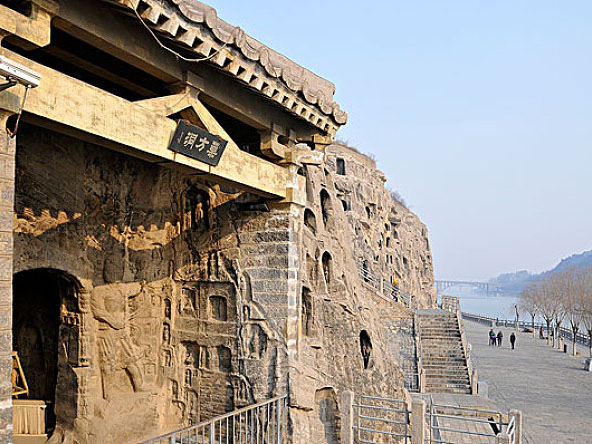 medical prescriptions carved inside ranging from internal medicine, surgery, paediatrics, ophthalmology and otorhinolaryngology, etc. The medicine and drugs mentioned in these prescriptions are herbs, animals and mineral drugs all available in daily life, making it convenient for common use. These medicines are not only for ordinary diseases, but also for some unusual illnesses like oesophagus cancer. A Japanese scholar included 95 kinds of prescriptions discovered here into his book in the 10th Century. These prescriptions offer a valuable source for us to study the ancient Chinese medicine.
medical prescriptions carved inside ranging from internal medicine, surgery, paediatrics, ophthalmology and otorhinolaryngology, etc. The medicine and drugs mentioned in these prescriptions are herbs, animals and mineral drugs all available in daily life, making it convenient for common use. These medicines are not only for ordinary diseases, but also for some unusual illnesses like oesophagus cancer. A Japanese scholar included 95 kinds of prescriptions discovered here into his book in the 10th Century. These prescriptions offer a valuable source for us to study the ancient Chinese medicine.  It’s said that Empress Wu Zetian personally attended the grand ceremony for the opening of the road. The majestic ancient musicians beat the drums on the platform, giving it the name ‘Platform for Drum Beating’. Adjacent to the platform are three caves, in including the Leigutai North Cave.
It’s said that Empress Wu Zetian personally attended the grand ceremony for the opening of the road. The majestic ancient musicians beat the drums on the platform, giving it the name ‘Platform for Drum Beating’. Adjacent to the platform are three caves, in including the Leigutai North Cave. 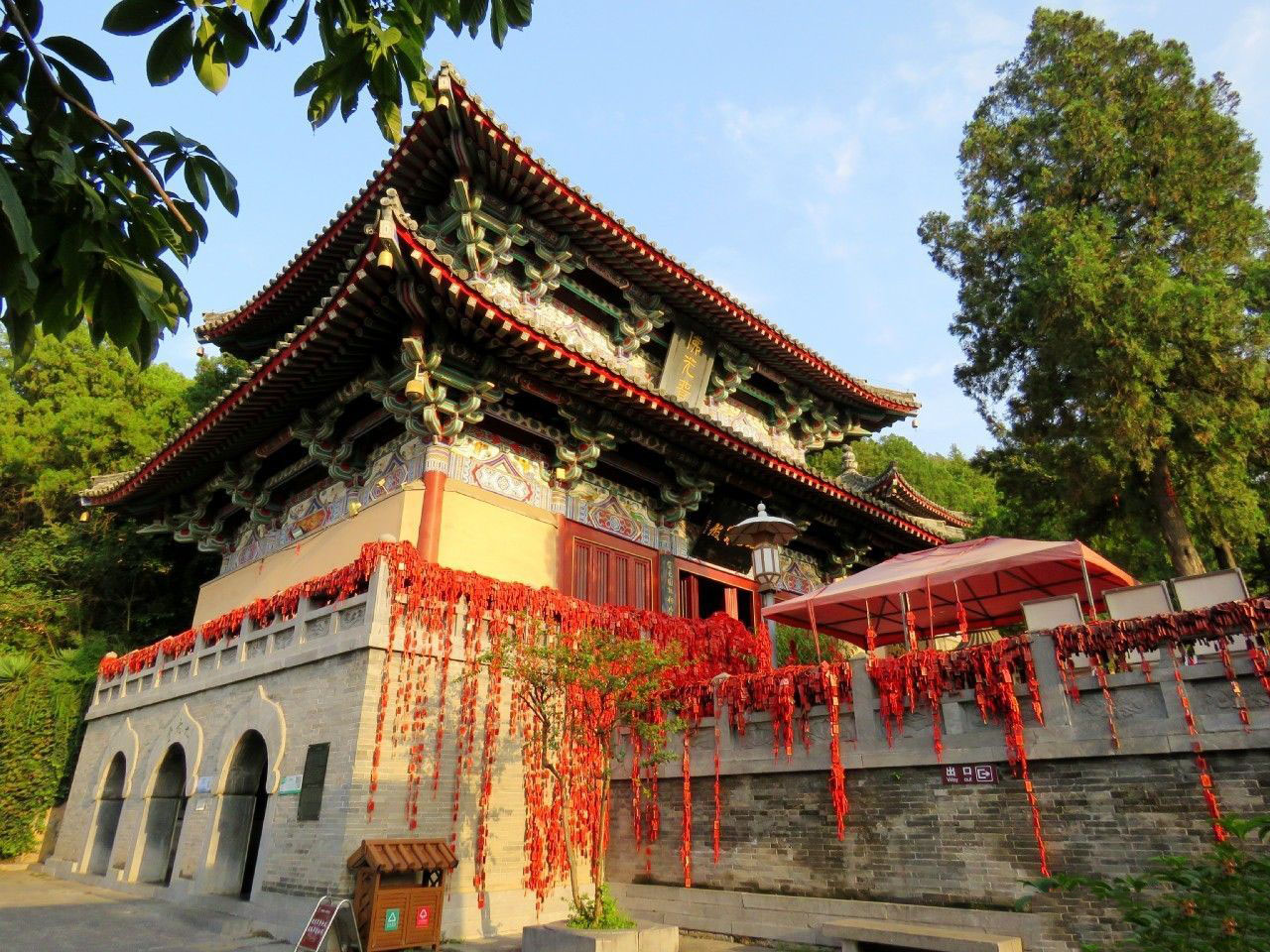 It was built in 516 (North Wei Dynasty). In 687 (Tang Dynasty), the great Indian Monk Divakara died and the temple was refurbished in order to bury him there. In 690, Wu Zetian ascended the throne and built the Wu Zhou Dynasty. Lord Liang Wu Sansi petitioned the name “Xiangshan Temple” from the Empress. The Empress herself visited the temple constantly. In 832, the great poet Bai Juyi generously donated to restore the temple and left us the masterpiece “Restoration of Xiangshan Temple”, gaining it a lot of fame. In 846, Bai Juyi passed away and was buried beside here. In later Dynasties, the temple was gradually abandoned until during the Qing Dynasty when Emperor Qinlong made visits here and left two poems inscribed on the stones. In modern times, the government paid very little attention to the temple until Chiang Kai Shek came to power. He built a villa southeast of the temple. The recent restoration took place between 2002 and 2003 when the municipal government invested a great deal in the whole temple and added a few more structures.
It was built in 516 (North Wei Dynasty). In 687 (Tang Dynasty), the great Indian Monk Divakara died and the temple was refurbished in order to bury him there. In 690, Wu Zetian ascended the throne and built the Wu Zhou Dynasty. Lord Liang Wu Sansi petitioned the name “Xiangshan Temple” from the Empress. The Empress herself visited the temple constantly. In 832, the great poet Bai Juyi generously donated to restore the temple and left us the masterpiece “Restoration of Xiangshan Temple”, gaining it a lot of fame. In 846, Bai Juyi passed away and was buried beside here. In later Dynasties, the temple was gradually abandoned until during the Qing Dynasty when Emperor Qinlong made visits here and left two poems inscribed on the stones. In modern times, the government paid very little attention to the temple until Chiang Kai Shek came to power. He built a villa southeast of the temple. The recent restoration took place between 2002 and 2003 when the municipal government invested a great deal in the whole temple and added a few more structures. 
Price: 90 RMB pp;
Battery Car: 10 RMB/way.
3 Days Terracotta Warriors & Longmen Grottoes Tour
5 Days Xian & Luoyang Heritage Tour
Copyright © 2019 Lily Sun China Tours International, Inc. Terms &conditions | Privacy Policy | Sitemap